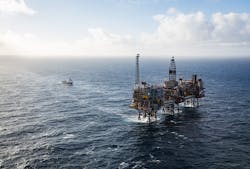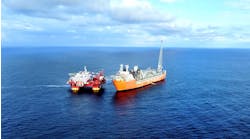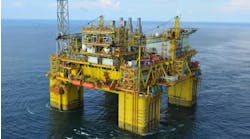Offshore staff
LYSAKER, Norway – Aker BP has commemorated 35 years of production at the Ula field in the southern Norwegian North Sea.
In October 1986, the goal had been to sustain production for 10-11 years, but Ula has since delivered nearly 600 MMboe, more than three times the volumes anticipated at start-up.
Now Aker BP and its partners aim to continue operations until 2032.
BP acquired two-thirds of the surrounding license 019 in 1976, discovering oil shortly afterwards 70 m (230 ft) below the point where a previous well had been terminated in 1968.
The company, with an ownership interest of 70%, took on operatorship of the development that followed, comprising bridge-linked living quarters, drilling and process platforms, with oil transported via the Ekofisk complex to Teesside in northeast England.
Until 1998, the gas was sent to Ekofisk via the Cod facilities.
Ula’s prime late-Jurassic sandstone reservoir was thought to hold almost 1 Bboe of oil and NGLs. In 1998, BP started alternating water injection and gas injection (WAG) to produce more oil from the reservoir, and all the produced gas has since been re-injected into the Ula reservoir to raise oil recovery.
In 1983, the company discovered the nearby Tambar field, which it went on to develop via a normally unmanned platform remotely operated from Ula.
Tambar (2001), Blane (2007), Oselvar (2012) and later Oda (2019) were all connected to the infrastructure. The WAG program has been expanded by injecting the produced gas from these fields.
Now Aker BP aims to produce at least 70 MMbbl more from the Ula area by 2032.
Jorunn Kvåle, vice president Operations & Asset development for Ula, said: “We’re drawing up technical lifetime plans that define what we have to do to keep the facilities operating safely for the remaining period.
“We’re conducting equivalent analyses to preserve well integrity and implement the well maintenance necessary to protect production. At the same time, we need to continually look for opportunities to improve the rate of production and recovery using new technology.”
10/13/2021



